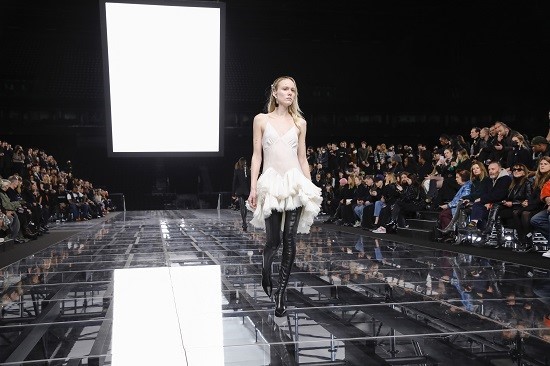In a cold, dark airplane hangar on the
edge of
Paris, as reports broke of more than 1.5 million refugees fleeing
through Europe from Ukraine, Demna, the mononymic designer of Balenciaga who
had fled
Georgia as a 12-year-old during that country’s civil war, built an
enormous snow globe and let loose a storm.
اضافة اعلان
Into the wind struggled men and women clutching faux
trash bags seemingly filled with belongings, slipping in spike-heeled boots,
clutching big black coats that flew out around them, heads down. A few were
shivering in boxer shorts, with only towellike shawls for protection. Long
dresses streamed backward. The music pounded; overhead, lights flashed in the
obscured sky.
Outside the glass an audience watched, clutching
blue and yellow T-shirts the shades and almost the size of the
Ukrainian flag
that had been left on every seat, along with a note from the designer.
The war had, Demna wrote in the note, “triggered the
pain of a past trauma I have carried in me since 1993, when the same thing
happened in my country and I became a forever refugee. Forever, because that’s
something that stays with you. The fear, the desperation, the realization that
no one wants you.”
 (Photo: NYTimes)
(Photo: NYTimes)
Thus, Demna did a collection originally meant as a
commentary on climate change — a theme Demna began exploring before the
pandemic and which he here intended as a meditation on an imaginary future
where snow is relegated to the status of man-made fantasy — become instead an
exceptionally powerful response to war.
For the last week and a half of conflict,
fashion has been almost apologetic about its own existence; about daring to offer a
frivolous, unnecessary product amid a global crisis. There’s been a lot of lip
service to the idea of beauty as a salve; a lot of “All I can do is what I do
best” sort of thing. A lot of reminding about all the people that the industry
employs.
It was built on a single shade: a sort of signature
hot pink — dubbed Pink PP, about to become an official Pantone color — that
also was the tint of the walls and floor. There was a brief section of black,
as a sort of palate cleanser, but it was the pink that stood out And offered an
update to the classic Valentino red. Pink everywhere you looked, except the
faces, which stood out, each on its own. The effect was a little dizzying, but
it made the point.
Of course, simply getting down to the job, as
Matthew Williams did at Givenchy, is OK too.
He combined the streetwear influences first brought
to the brand by Riccardo Tisci (layered tees, like a tour through logos past;
nylon hooded anoraks beneath tailored jackets; thigh-high leather boots) with
its clichés (“Breakfast at Tiffany’s” pearls; ruffled amalgamations of tulle
and organza) plus his own affinity for a bit of hardware. The result was his
most coherent collection yet.
Yet there’s no reason, as Demna proved, that
designers should be afraid of grappling with the tough stuff. He had almost, he
said in his notes, canceled the Balenciaga show, until “I realized canceling
this show would mean giving in.” So instead, he shook it up. It was a risk.
After all, very expensive leather trash bags veer
dangerously close to deeply bad taste. Although this is the same designer that
made very expensive versions of the Ikea bag. Part of his shtick is elevating
the unseen everyday to deluxe status, poking fun at the pomposity of the
fashion beast.
And the fact that some of his models were wrapped in
Balenciaga-branded packing tape catsuits could seem very much like a
runway-only social-media-catnip gimmick.
Yet backstage, after the show, Demna said the tape
wasn’t just a joke — it was also a nod to the dress-up experiments he’d done as
a rootless child. And that they’d be selling the rolls in stores, so everyone
would be able to DIY their own look, in a sort of extreme version of make do
and mend.
One that made
crystal clear that for him, the clothes themselves, in ready-to-wear anyway,
may be the least of the matter. After all, a dress silk-screened to mimic lace
and bags made from melded pairs of boots, long jersey dresses, hoodies,
asymmetric florals, and enveloping greatcoats — looked pretty much the same as
it has for a few seasons now.
But combined with the
Simpsons show of last season;
the experiments with virtual reality; the earlier immersive climate change
scenarios; plus the Donda shows he worked on with Ye; the roiling depiction of
refugees under glass confirmed Demna’s position as the greatest scenographer in
fashion, and its most fearless.
His subject isn’t silhouette, it’s the human condition — on
an epic, pop culture scale.
Read more Fashion



